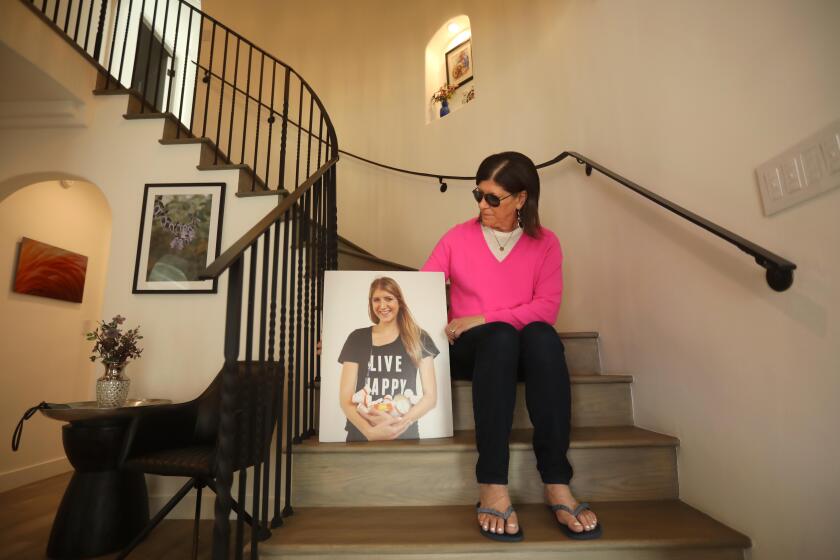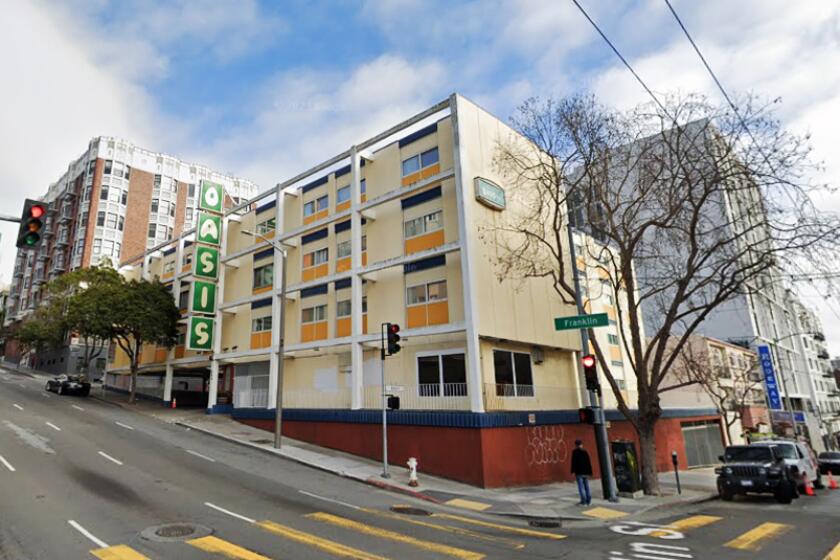WESTSIDE / COVER STORY : Wheeling and Dealing : Street Vendors Risk Citations and the Ire of Other Merchants as They Try to Eke Out a Living
“Are those things aguacates ?” asked a female passerby as she strolled past Maria Mendez’s display of huge, bright-green Florida avocados, stacked neatly on a curb near the busy intersection of Santa Monica Boulevard and Western Avenue.
Mendez nodded, her weathered face smiling from behind a tropical array of mangoes, coconuts, pineapples, bananas, oranges, plantains and the cantaloupe-sized avocados.
“They’re very good,” she said. “Three dollars each, or two for five.”
The passerby paused briefly, then moved on.
“Ah, that’s the nature of the business,” sighed the 54-year-old Salvadoran refugee, leaning against a chain-link fence and adjusting the baseball cap covering her closely shorn silver hair. “Some days you sell, others you don’t.”
A philosophical outlook is as necessary as good stock in the precarious world of street vendors, the hard-working, cart-wheeling hawkers who remind us--in a world defined by mergers and multinationals--that anyone can have their own business.
From fresh fruit to Frisbees, cotton T-shirts to steel hammers, the vendors may not offer customers one-stop shopping. But what a single street stand or cart may lack in variety, it more than makes up in convenience and/or price.
And street-legal or not, on a gritty street corner in Hollywood, along the funky boardwalk of Venice or near a tony neighborhood in Santa Monica--and even in Beverly Hills--street vendors are becoming as familiar a part of our landscape as palm trees and traffic signals.
The Orange Seller
For Virgilio Pueblas Serate, the day begins at 4 a.m. A professional folk musician, Serate makes ends meet by selling oranges and peanuts on street corners throughout Los Angeles. Early, he and fellow vendors rise to buy their merchandise at downtown wholesale warehouses.
By 9 a.m., he is out on the street, braving exhaust fumes while selling bags of 16 oranges for $2 or a bag of peanuts for a buck. On one recent morning, he was in Culver City. At the corner of Robertson and Venice boulevards, he had one goal: to sell that day’s 35 bags of oranges.
“We make little money, but we make good use of it,” said Serate, 28. “It is better to live life selling oranges than selling things that are bad for your health. That’s how we get through life.”
But the nature of his job makes life less than stable. In Culver City, as in most cities in the Los Angeles area, it is illegal to sell merchandise without a permit or a license. Serate, like other unlicensed street vendors, must be prepared to leave a street corner when asked by law enforcement officials. Serate says he is aware of that and obeys.
“We have to obey the traffic laws, otherwise we can cause accidents,” he said, waving away a driver who stopped as the light turned green.
In the scheme of things, Culver City police say, regulating street vendors is not a high law enforcement priority. But when they get citizen complaints, police say, they respond.
“Let me put it this way, we don’t have a vendor-undercover team out there,” said Lt. Tom Gabor, community relations officer. “But to just say, ‘Hey, it’s neat and it adds culture to the community,’ is totally inappropriate in our opinion.”
To operate legally, street vendors in Culver City must obtain a permit, pay a $105 fee and purchase a moving vehicle or cart. Stationary sidewalk vending is not permitted. Because of a fingerprint check required by the California Department of Justice, the process to obtain a permit can take up to six months, said Alida Ostler, revenue supervisor for Culver City. Citywide, she says, about 50 to 100 people are licensed as street vendors.
“Illegal street vending is really not an issue. Historically, we have not allowed it,” Ostler said. And because of Culver City’s zigzag geography, she said, it seems an unlikely candidate for the experimental vending districts being tried in other cities.
Like Los Angeles.
A year ago, the Los Angeles City Council approved a two-year pilot program that allows vendors--with business permits--to set up districts for sales. But midway through that experiment, the program has had mixed results. To date, the city has only received applications from two vendor groups and in neither case has a pilot business district been established. At this rate, city officials say, it is unlikely that the goal of eight districts will be reached by the time the program ends.
That would be a setback for vendors and their advocates who have been trying since the late 1980s to counter the city’s strict enforcement of laws against street sales. As those unregulated businesses proliferated with a surge in Latin American immigration, police crackdowns and misdemeanor fines of up to $1,000 led vendors and their supporters to organize. Eventually their ranks grew strong enough to persuade the city to allow the pilot program.
The program has made its clearest progress in the Santa Monica and Western area, where Maria Mendez may soon be able to focus on her work and not on fear of police and their citations. The intersection, where she wheels out her rusty shopping cart every day, will probably become the city’s first zone approved for legal vending.
“I am thankful for that ordinance, and for the people who worked to organize this district,” she said. “We won’t have to be so nervous anymore, worrying about whether or not the police will come and take our things, afraid to set up if they’re around.”
On a windy corner near Baldwin Hills Crenshaw Plaza, Vietnam veteran John Basil shares the spot on which he sells framed prints and clothing with Walter Herman Charlton, a World War II veteran who has been selling handmade dolls for 25 years.
“I have mixed feelings about this entire district thing,” said Basil, who was forced to become a street vendor after losing three stores in the 1992 riots. He dreams of setting up a new store with Charlton.
As dry-goods vendors, Basil and Charlton would have to pay about $1,500 each to sell under the ordinance. They contend that the costs will be more affordable to established merchants who wish to do a little street business than to vendors like themselves.
“The way they’re setting this up, they’re inviting people with money,” Basil said. “Fifteen hundred dollars might as well be $15 million to us right now.”
Of course, if the district concept flops, vendors will just keep doing what they’re doing--risking citations while they try to eke out a living.
On the busy intersection of Western Avenue and Santa Monica Boulevard, passersby can buy anything from socks to jewelry to fresh vegetables and fruits and hardware. Yet, vendors are lucky to make up to $30 on a good day.
Mauricio, an immigrant from El Salvador, has set up a makeshift tool and hardware stand. He is aware of the neighborhood complaints on trash accumulating in the vending area, so he and his wife Rosa take pains to keep their corner clean. “We want to (keep) this area clean, so we pick up the trash,” he said.
Despite such efforts, some police officials and neighborhood watch organizations fear that legalizing the sidewalk vending district will only increase the trash problem, as well as pedestrian and vehicle traffic.
“We get complaints all the time,” said Sgt. Jim Mateer of LAPD’s Hollywood Division.
Added Tina Farash, president of the Hobart Boulevard Neighborhood Watch and Homeowners Assn.: “I have nothing against creating a legal area for vending. The problem is with the area they chose.”
But Councilwoman Jackie Goldberg, whose district includes Hollywood, says even if there are flaws in the proposal to legalize street vending, it is better than the current situation.
“If this doesn’t work we won’t be any worse off than we are now. What we have now is untenable,” Goldberg said, stressing the importance of regulating vendors whether they are legal or not.
Squaring Off in Venice
For years, the western edge of the Venice boardwalk has been a magnet for peddlers seeking tourist dollars amid the area’s year-round carnival atmosphere.
But the activity has generated conflict because many vendors--some illegal and selling everything from incense and candles to homemade trinkets--often set up displays directly across from the boardwalk’s commercial merchants. The ones who pay for permits.
“It’s not fair; we pay rent and taxes and they don’t,” said Hwan Song, a store owner and chairman of the Venice Beach Merchant Assn.
Many store owners blame the illegal activity for lost business and declining revenues.
Current law bans sales on the boardwalk but allows nonprofit and free speech groups to sell merchandise. Last April, city recreation and parks commissioners proposed further restrictions by requiring that sellers “inextricably intertwine” their messages within their products and limit their display space to six feet. The restrictions are still being reviewed by attorneys.
Meantime, the City Council--pressed by merchants--passed a motion last summer requiring the recreation department to hire additional patrol officers to police the boardwalk. But that five-month pilot program, which began in September, has failed to stem illegal acts, according to store owners.
“Nothing has been enforced and the situation has just gotten worse,” said Mark Ryavec, executive director of the Venice Boardwalk Assn.
But others believe parts of the current law--as well as the proposed restrictions--are unenforceable and will destroy the spirit of the freewheeling boardwalk.
“We are not talking about protecting (street) vendors who sell T-shirts or sunglasses but protecting those creative artisans who must have a way to sell their wares--those who can’t afford a commercial rent,” said community activist Jerry Rubin.
One vendor, Tom Law, said he had been in town for the past two weeks and hoped to sell almost a dozen of his remaining T-shirts before moving on to Utah. In the past few days, Law said, he had received conflicting signals: A recreation and parks ranger said he could offer his wares for donations only, but a Los Angeles police officer told him to move on.
“Everyone knows what’s going on--it’s like one big Grateful Dead show out here, only a little stranger,” said Law, a voluble man wearing a beard, a baseball hat and loose-fitting clothing. “I think we should be allowed to sell our products because it brings in the tourists and we are not competing with any Venice merchants.”
A Tight Leash
In West Hollywood, street vending laws are considerably tighter and city officials say violations are relatively rare. A brief flare-up occurred last spring when a group of Russian vendors attempted to revert to the ways of the old country by setting up fruit and vegetable stalls near Plummer Park. But sheriff’s deputies soon quashed the effort.
Last January, the City Council passed an ordinance allowing some sidewalk vending. Five vendors now operate with city permits. “Our perception is that illegal vendors add to the deterioration of a city,” said city spokeswoman Helen Goss.
Santa Monica has also kept a tight leash on sidewalk vendors.
Management companies contracted by the city operate street vendor programs at the Santa Monica Pier and the Third Street Promenade. The activity consists of pushcart concessions, which are owner operated. The vendors offer such products as ceramics, jewelry, flowers, churros and pretzels, which generally do not compete with Promenade stores. An antique and collectibles show of about 180 vendors, which is open to the public, is held once a month at Santa Monica Airport.
“Because we’re a small city, we have the resources to keep an eye on things to a greater extent than the City of Los Angeles,” said Kenyon Webster, a Santa Monica planning manager.
If Santa Monica seems restrictive, consider Beverly Hills, where outdoor vending predictably takes on a style all its own.
In a city renowned for its upscale retail shops, vending is strictly limited to pushcarts selling gourmet coffees, bakery goods and cut flowers.
Michael Cohen, owner of Karma Kappuccino, is one of only two vendors peddling caffe lattes from glossy wood and brass carts in Beverly Hills.
“It’s great for the ambience of the area,” said Cohen, his $30,000 pushcart strategically placed at the edge of a shopping mall on Rodeo Drive. “The merchants love it, because it allows shoppers to rejuvenate and encourages people to stay and look in the area.”
That pedestrian-friendly atmosphere is what the new outdoor vending program is targeting. Launched in December, the program allows pushcarts on private property, and gives the Beverly Hills City Council discretion to allow additional outdoor vending on some public land.
In the past, Beverly Hills has prohibited sales outside permanent structures, and required even infrequent street peddlers to have a business license.
Although he said he is in favor of permitting more vendors, Cohen said his business has dropped about 10% since a rival cart started up a block away. Still, he estimates his single cart brings in about $100,000 a year.
And in the meantime, it does not appear Cohen will be facing more competition any time soon.
The city, officials say, has not received any applications from other would-be vendors.
More to Read
Start your day right
Sign up for Essential California for news, features and recommendations from the L.A. Times and beyond in your inbox six days a week.
You may occasionally receive promotional content from the Los Angeles Times.






